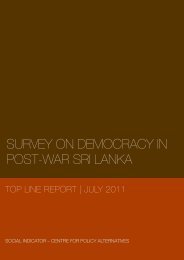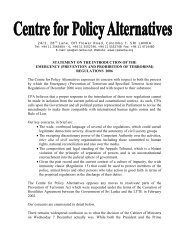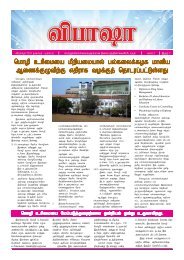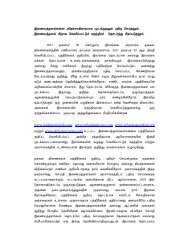States of Emergency - Centre for Policy Alternatives
States of Emergency - Centre for Policy Alternatives
States of Emergency - Centre for Policy Alternatives
Create successful ePaper yourself
Turn your PDF publications into a flip-book with our unique Google optimized e-Paper software.
alarm concerns natural disasters, scarcity <strong>of</strong> basic commodities or<br />
essential services; a state <strong>of</strong> emergency is declared where ‘the free<br />
exercise <strong>of</strong> the citizen’s rights and liberties or the normal<br />
functions <strong>of</strong> democratic institutions, public services essential <strong>for</strong><br />
the community or any other aspect <strong>of</strong> public order are altered to<br />
the extent that the ordinary powers prove insufLicient to reestablish<br />
or maintain them’; and a state <strong>of</strong> siege is proclaimed ‘in<br />
the event <strong>of</strong> an insurrection or threat <strong>of</strong> insurrection or an act <strong>of</strong><br />
<strong>for</strong>ce against the sovereignty or independence, territorial integrity<br />
and constitutional order <strong>of</strong> Spain which cannot otherwise be<br />
resolved.’ 97<br />
As with any constitutional design options, the choice <strong>of</strong><br />
arrangements depend upon an assessment <strong>of</strong> the strengths and<br />
weakness <strong>of</strong> each option in the light <strong>of</strong> political context. The dual<br />
and multilevel classiLications <strong>of</strong> emergencies are aimed at limiting<br />
the range <strong>of</strong> extraordinary powers available to government<br />
through a system <strong>of</strong> calibration. Thus varying degrees <strong>of</strong> threat are<br />
tied to a corresponding cascade <strong>of</strong> legal powers available. These<br />
models there<strong>for</strong>e are acutely concerned about the equation<br />
between power and liberty, legally regulating the increment <strong>of</strong> the<br />
<strong>for</strong>mer and corresponding decrement <strong>of</strong> the latter (especially in<br />
regard to constitutionally enshrined fundamental rights) strictly<br />
according to the gravity <strong>of</strong> the threat.<br />
On the other hand, the classiLicatory approach to the structuring<br />
<strong>of</strong> emergency powers has its disadvantages. Gross and Ní Aoláin<br />
point out two broad problems, even assuming, as they say, “that<br />
such classiLication and categorisation are viable projects.” 98 Firstly,<br />
97<br />
European Commission <strong>for</strong> Democracy through Law (1995), op cit., pp.<br />
7‐8<br />
98<br />
Gross and Ní Aoláin: p.45<br />
73











